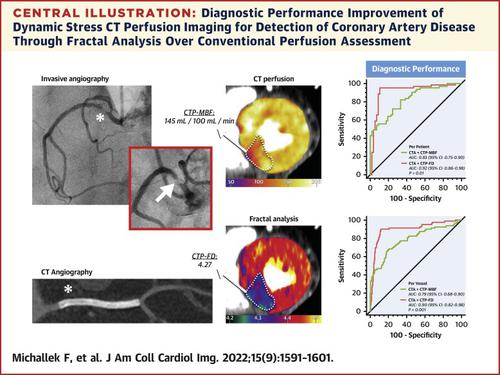JACC: Cardiovascular Imaging ( IF 14.0 ) Pub Date : 2022-05-11 , DOI: 10.1016/j.jcmg.2022.03.015 Florian Michallek 1 , Satoshi Nakamura 2 , Tairo Kurita 3 , Hideki Ota 4 , Kensuke Nishimiya 5 , Ryo Ogawa 6 , Takehito Shizuka 7 , Hitoshi Nakashima 8 , Yining Wang 9 , Tatsuro Ito 10 , Hajime Sakuma 2 , Marc Dewey 11 , Kakuya Kitagawa 12

|
Background
Combined computed tomography–derived myocardial blood flow (CTP-MBF) and computed tomography angiography (CTA) has shown good diagnostic performance for detection of coronary artery disease (CAD). However, fractal analysis might provide additional insight into ischemia pathophysiology by characterizing multiscale perfusion patterns and, therefore, may be useful in diagnosing hemodynamically significant CAD.
Objectives
The purpose of this study was to investigate, in a multicenter setting, whether fractal analysis of perfusion improves detection of hemodynamically relevant CAD over myocardial blood flow quantification (CTP-MBF) using dynamic, 4-dimensional, dynamic stress myocardial computed tomography perfusion (CTP) imaging.
Methods
In total, 7 centers participating in the prospective AMPLIFiED (Assessment of Myocardial Perfusion Linked to Infarction and Fibrosis Explored with Dual-source CT) study acquired CTP and CTA data in patients with suspected or known CAD. Hemodynamically relevant CAD was defined as ≥90% stenosis on invasive coronary angiography or fractional flow reserve <0.80. Both fractal analysis and CTP-MBF quantification were performed on CTP images and were combined with CTA results.
Results
This study population included 127 participants, among them 61 patients, or 79 vessels, with CAD as per invasive reference standard. Compared with the combination of CTP-MBF and CTA, combined fractal analysis and CTA improved sensitivity on the per-patient level from 84% (95% CI: 72%-92%) to 95% (95% CI: 86%-99%; P = 0.01) and specificity from 70% (95% CI: 57%-82%) to 89% (95% CI: 78%-96%; P = 0.02). The area under the receiver-operating characteristic curve improved from 0.83 (95% CI: 0.75-0.90) to 0.92 (95% CI: 0.86-0.98; P = 0.01).
Conclusions
Fractal analysis constitutes a quantitative and pathophysiologically meaningful approach to myocardial perfusion analysis using dynamic stress CTP, which improved diagnostic performance over CTP-MBF when combined with anatomical information from CTA.
中文翻译:

动态应力 CT 灌注成像检测血液动力学相关冠状动脉疾病的分形分析
背景
联合计算机断层扫描衍生的心肌血流量 (CTP-MBF) 和计算机断层扫描血管造影 (CTA) 已显示出检测冠状动脉疾病 (CAD) 的良好诊断性能。然而,分形分析可能通过描述多尺度灌注模式来提供对缺血病理生理学的额外洞察,因此可能有助于诊断具有血液动力学意义的 CAD。
目标
本研究的目的是在多中心环境中研究灌注的分形分析是否比使用动态、4 维、动态应力心肌计算机断层扫描灌注 (CTP) 的心肌血流定量 (CTP-MBF) 提高血液动力学相关 CAD 的检测)成像。
方法
总共有 7 个中心参与了前瞻性 AMPLIFiED(使用双源 CT 探索与梗死和纤维化相关的心肌灌注评估)研究,获得了疑似或已知 CAD 患者的 CTP 和 CTA 数据。血流动力学相关的 CAD 定义为有创冠状动脉造影显示狭窄≥90% 或血流储备分数 <0.80。分形分析和 CTP-MBF 量化均在 CTP 图像上进行,并与 CTA 结果相结合。
结果
该研究人群包括 127 名参与者,其中 61 名患者或 79 条血管按照侵入性参考标准患有 CAD。与 CTP-MBF 和 CTA 的组合相比,分形分析和 CTA 的组合将每个患者水平的敏感性从 84%(95% CI:72%-92%)提高到 95%(95% CI:86%-99 %;P = 0.01)和特异性从 70%(95% CI:57%-82%)到 89%(95% CI:78%-96%;P = 0.02)。接受者操作特征曲线下的面积从 0.83(95% CI:0.75-0.90)改善至 0.92(95% CI:0.86-0.98;P = 0.01)。
结论
分形分析构成了一种使用动态应力 CTP 进行心肌灌注分析的定量且具有病理生理学意义的方法,当与 CTA 的解剖信息相结合时,它提高了 CTP-MBF 的诊断性能。


























 京公网安备 11010802027423号
京公网安备 11010802027423号